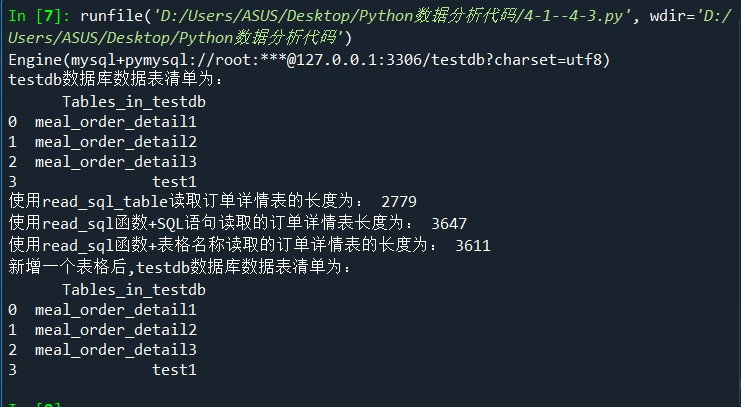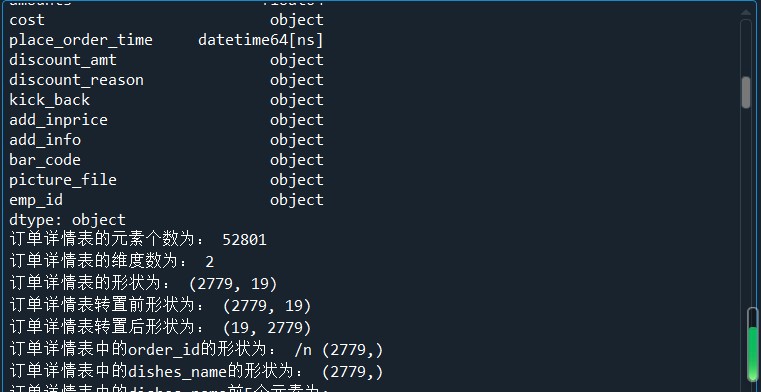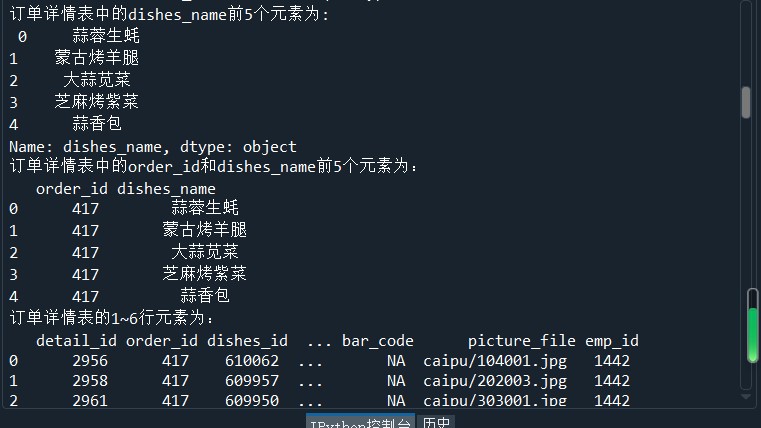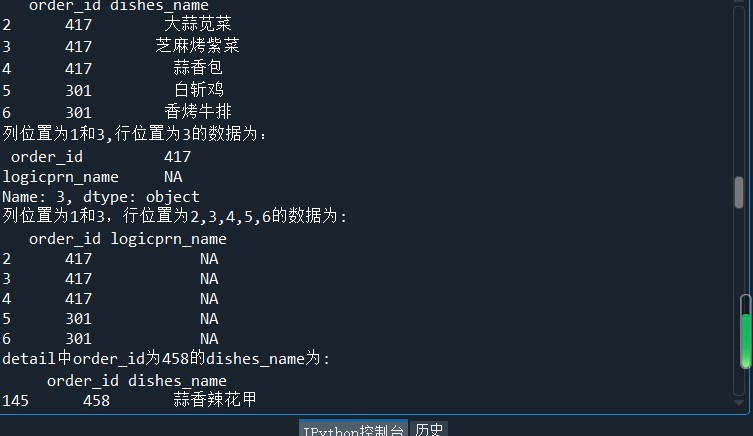| 项目 | 内容 |
| 课程班级博客链接 | https://edu.cnblogs.com/campus/pexy/20sj |
| 这个作业要求链接 | https://edu.cnblogs.com/campus/pexy/20sj/homework/12597 |
| 博客名称 | 2003031120—廖威—Python数据分析第七周作业—MySQL的安装以及使用 |
| 要求 | 每道题要有题目,代码(使用插入代码,不会插入代码的自己查资料解决,不要直接截图代码!!),截图(只截运行结果) |
题目一:扩展阅读心得体会
1.扩展阅读:小白必看!超详细MySQL下载安装教程
2.扩展阅读:MySQL教程
3.扩展阅读:MySQL卸载
题目二:
1.安装好MySQL,连接上Navicat。
2.完成课本练习(代码4-1~3/4-9~31)。
from sqlalchemy import create_engine #创建一个MYSQL连接器,用户名为root,密码为111 #地址为127.0.0.1,数据库名称为testdb,编码为UTF-8 engine = create_engine('mysql+pymysql://root:111@127.0.0.1:3306/testdb?charset=utf8') print(engine) import pandas as pd #使用read_sql_query查看testdb中的数据表数目 formlist = pd.read_sql_query('show tables',con = engine) print('testdb数据库数据表清单为:','\n',formlist) #使用read_sql_table读取订单详情表 detail1 = pd.read_sql_table('meal_order_detail1',con = engine) print('使用read_sql_table读取订单详情表的长度为:',len(detail1)) #使用read_sql读取订单详情表 detail2 = pd.read_sql('select * from meal_order_detail2',con = engine) print('使用read_sql函数+SQL语句读取的订单详情表长度为:',len(detail2)) detail3 = pd.read_sql('meal_order_detail3',con = engine) print('使用read_sql函数+表格名称读取的订单详情表的长度为:',len(detail3)) #使用to_sql存储orderData detail1.to_sql('test1',con = engine,index = False,if_exists = 'replace') #使用read_sql读取test表 formlist1 = pd.read_sql_query('show tables',con = engine) print('新增一个表格后,testdb数据库数据表清单为:','\n',formlist1)
#导入SQLAIchemy库的creat_engine函数 from sqlalchemy import create_engine import pandas as pd #创建一个MYSQL连接器,用户名为root,密码为111 #地址为127.0.0.1,数据库名称为testdb engine = create_engine('mysql+pymysql://root:111@127.0.0.1:3306/testdb?charset=utf8') #使用read_sql_table读取订单详情表 order1 = pd.read_sql_table('meal_order_detail1',con = engine) print('订单详情表1的长度为:',len(order1)) order2 = pd.read_sql_table('meal_order_detail2',con = engine) print('订单详情表2的长度为:',len(order2)) order3 = pd.read_sql_table('meal_order_detail3',con = engine) print('订单详情表3的长度为:',len(order3)) #使用read_table读取订单信息表 orderInfo = pd.read_table('D:/Users/ASUS/Desktop/meal_order_info.csv',sep = ',',encoding = 'gbk') print('订单信息表长度为:',len(orderInfo)) #读取users.xlsx文件 userInfo = pd.read_excel('D:/Users/ASUS/Desktop/users.xlsx') print('客户信息表长度为:',len(userInfo)) from sqlalchemy import create_engine import pandas as pd engine = create_engine('mysql+pymysql://root:111@127.0.0.1:3306/testdb?charset=utf8')#创建数据库连接 detail= pd.read_sql_table('meal_order_detail1',con = engine) print('订单详情表的索引为:',detail.index) print('订单详情表的所有值为:','\n',detail.values) print('订单详情表的列名为:','\n',detail.columns) print('订单详情表的数据类型为:','\n',detail.dtypes) #查看DataFrame的元素个数 print('订单详情表的元素个数为:',detail.size) print('订单详情表的维度数为:',detail.ndim) #查看DataFrame的维度数 print('订单详情表的形状为:',detail.shape) #查看Dataframe的形状 print('订单详情表转置前形状为:',detail.shape) print('订单详情表转置后形状为:',detail.T.shape) #使用字典访问的方式取出orderInfo中的某一列 order_id = detail['order_id'] print('订单详情表中的order_id的形状为:','/n',order_id.shape) #使用访问属性的方式取出orderInfo中的菜品名称列 dishes_name = detail.dishes_name print('订单详情表中的dishes_name的形状为:',dishes_name.shape) dishes_name5 = detail['dishes_name'][:5] print('订单详情表中的dishes_name前5个元素为:','\n',dishes_name5) orderDish = detail[['order_id','dishes_name']][:5] print('订单详情表中的order_id和dishes_name前5个元素为:','\n',orderDish) order5 = detail[:][:6] print('订单详情表的1~6行元素为:','\n',order5) print('订单详情表中前5行数据为:','\n',detail.head()) print('订单详情表中后5行数据为:','\n',detail.tail()) dishes_namel = detail.loc[:,'dishes_name'] print('使用loc提取dishes_name列的size为:',dishes_namel.size) dishes_name2 = detail.iloc[:,3] print('使用iloc提取第3列的size为:',dishes_name2.size) orderDish1 = detail.loc[:,['order_id','dishes_name']] print('使用loc提取order_id和dishes_name列的size为:',orderDish1.size) orderDish2 = detail.iloc[:,[1,3]] print('使用iloc提取第1和第3列的size为:',orderDish2.size) print('列名为order_id和dishes_name的行名为3的数据为:\n',detail.loc[3,['order_id','dishes_name']]) print('列名为order_id和dishes_name行名为2,3,4,5,6的数据为:\n',detail.loc[2:6,['order_id','dishes_name']]) print('列位置为1和3,行位置为3的数据为:\n',detail.iloc[3,[1,3]]) print('列位置为1和3,行位置为2,3,4,5,6的数据为:\n',detail.iloc[2:7,[1,3]]) #loc内部传入表达式 print('detail中order_id为458的dishes_name为:\n',detail.loc[detail['order_id']=='458',['order_id','dishes_name']]) #print('detail中order_id为458的第1、5列数据为:\n',detail.iloc[detail['order_id']=='458',[1,5]])#返回的为一个布尔值Series,而iloc可以接收的数据类型并不包括Series print('detail中order_id为458的第1、5列数据位:\n',detail.iloc[(detail['order_id']=='458').values,[1,5]]) print('列名为dishes_name行名为2,3,4,5,6的数据为:\n',detail.loc[2:6,'dishes_name']) print('列位置为5,行位置为2~6的数据为:\n',detail.iloc[2:6,5]) #print('列位置为5,行位置为2~6的数据为:', '\n',detail.ix[2:6,5])在pandas的1.0.0版本开始,移除了Series.ix and DataFrame.ix 方法。使用DataFrame的loc方法或者iloc方法进行替换吧。 #将order_id为458的变换45800 detail.loc[detail['order_id']=='458','order_id'] = '45800' print('更改后detail中order_id为458的order_id为:\n',detail.loc[detail['order_id']=='458','order_id']) print('更改后detail中order_id为45800的order_id为:\n',detail.loc[detail['order_id']=='45800','order_id']) detail['payment'] = detail['counts']*detail['amounts'] print('detail新增列payment的前5行为:','\n',detail['payment'].head()) detail['pay_way'] = '现金支付' print('detail新增列pay_way的前5行为:','\n',detail['pay_way'].head()) print('删除pay_way前detail的列索引为:','\n',detail.columns) detail.drop(labels = 'pay_way',axis = 1,inplace = True) print('删除pay_way后detail的列索引为:','\n',detail.columns) print('删除1~10行前detail的长度为:',len(detail)) detail.drop(labels = range(1,11),axis = 0,inplace = True) print('删除1~10行detail的长度为:',len(detail))
运行结果

















 浙公网安备 33010602011771号
浙公网安备 33010602011771号